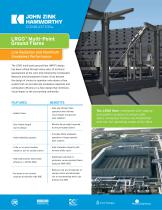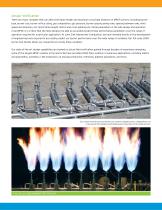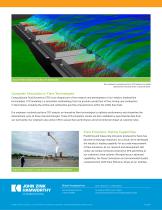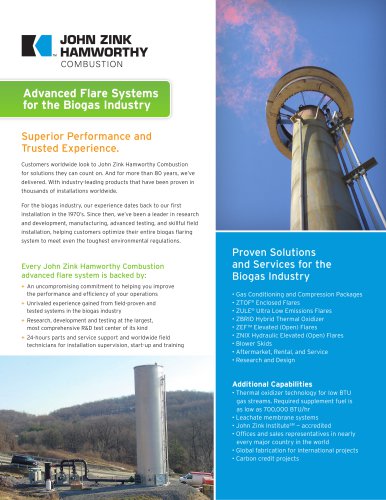 Website:
John Zink Hamworthy Combustion
Website:
John Zink Hamworthy Combustion
Catalog excerpts

The LRGO multi-point ground flare (MPGF) design has been refined through many years of technical development at the John Zink Hamworthy Combustion Research and Development Center. It has become the design of choice for operators who desire a flare system that can provide high smokeless capacities and combustion efficiency in a flare design that minimizes visual impact to the surrounding community. FEATURES BENEFITS Hidden flame Safe and efficient flare operation with minimal visual impact and ground level radiation Short flame length burner design Minimal fence height required to ensure hidden flames The LRGO flare is designed with staging and ignition systems to ensure safe, short, smokeless flames are maintained over the full operating range of the flare. High smokeless capacity Provides 100% smokeless operation of large-capacity flare systems Little or no assist medium + High smokeless capacity with (steam or air) for smoke control minimal utility costs High hydrocarbon destruction efficiency (> 99.5% DRE) Significant reduction in emissions versus elevated flares (typically 98% DRE) No steam or air controls required to maintain high DRE HAMWORTHY COMBUSTION* Reduces cost and complexity of smoke control and eliminates risk of oversteaming which can produce low DRE Airoil-Flaregas Peabody Engineering
Open the catalog to page 1
Burner Technologies The LRGO flare system features a unique range of burner designs that provide optimum flame stability, high hydrocarbon destruction efficiency (normally > 99.5% DRE) and many additional benefits. The LRGO-HC burner design is ideal for demanding applications when short flame length with reliable cross-lighting is required. Compared to conventional burners, the LRGO-HC burner allows for: + Much shorter flame lengths • Reliable cross-lighting at greater burner spacing • Better cross-lighting of low heating-value gases + Improved smokeless performance and turndown • Efficient...
Open the catalog to page 2
Design Verification There are many variables that can affect the flame length and maximum cross-light distance on MPGF burners, including burner type, burner size, burner orifice sizing, gas composition, gas pressure, burner spacing along rows, spacing between rows, wind speed and direction, etc. Since flame-length control and cross-lighting are critical parameters in the safe design and operation of an MPGF, it is critical that the flare designer be able to accurately predict these performance parameters over the range of operation required for a particular application. At John Zink...
Open the catalog to page 3
MULTI-POINT GROUND FLARE CFD MODELING Our engineers routinely perform CFD analysis to model operational characteristics of ground flares. Computer Simulation in Flare Technologies Computational Fluid Dynamics (CFD) is an integral part of the research and development of our industry leading flare technologies. CFD modeling is a simulation methodology that can provide a prediction of flow, mixing, and combustion in flare flames, including the airflow and combustion gas-flow characteristics within the LRGO flare field. Our engineers routinely perform CFD analysis on innovative flare...
Open the catalog to page 4All John Zink Hamworthy Combustion catalogs and technical brochures
-
Air-Assisted Flares
4 Pages
-
Duct Burner Solutions
2 Pages
-
Steam-Assisted Flares
4 Pages
-
TruFire™ High Energy Pilot
2 Pages
-
QLN®Burner
2 Pages
-
Steam Generation Solutions
6 Pages
-
Leachate Evaporators
2 Pages
-
Biogas Conditioning system
2 Pages
-
ZULE ® Biogas Flare
2 Pages
-
Complete Emissions Solutions
2 Pages
-
Poseidon® Flare
2 Pages
-
TANGENT Technology
2 Pages
-
HYDRA? Flare Tip
2 Pages
-
COOLstar® Burner
2 Pages
Archived catalogs
-
Sulphur Recovery Systems
3 Pages
-
SmartScan 121 Flame Scanner
3 Pages
-
Sequence 2000 Controller
5 Pages
-
S Series Pressure Jet Burner
3 Pages
-
Radio Burner
5 Pages
-
New corporate brochure
8 Pages
-
M Type Register Burner
7 Pages
-
LNOG Register Burner
7 Pages
-
HX Burner
5 Pages
-
Ground Flares
7 Pages
-
FPSO/FSO Boilers
1 Pages
-
Enviromix 2000 Burner
5 Pages
-
Elevated Flares
7 Pages
-
AMOxsafe® Gas Combustion Unit
5 Pages
-
Axiflo 6000 Burner
5 Pages
-
Blast Furnace Gas Burner
3 Pages
-
DF Register Burner
7 Pages
-
DFL Register Burner
7 Pages
-
DFR Burner
5 Pages
-
Diagnostic Display Systems
3 Pages
-
Electrotec Rotary Cup Burner
6 Pages
-
Envirojet Burner
6 Pages
-
Services and Spares
4 Pages
-
Alphatrim-Oxygen Trim
3 Pages










































